Comprehensive Business Capstone Project: Capsim Simulation and Ethics
VerifiedAdded on 2023/06/04
|11
|2865
|288
Project
AI Summary
This business capstone project explores ethical decision-making within the context of the Capsim business simulation. It begins with an introduction to the importance of ethical reasoning in managerial decisions, especially for graduates entering the workforce. The project then delves into the stages of organizational decision-making, including problem formulation, preliminary analysis, and strategic planning. It discusses different types of management decisions, such as programmable and non-programmable solutions, and organizational versus personal decisions. The project also examines the role of balanced scorecards in Comp XM activity and addresses ethical dilemmas faced by Comp XM workers, including privacy, confidentiality, and conflicts between laws and customer welfare. The project concludes by analyzing ethical principles in decision-making and the reasons for unethical business practices, emphasizing the need for improved ethical consciousness in modern organizations. This analysis provides a comprehensive overview of ethical considerations in business strategy and decision-making.
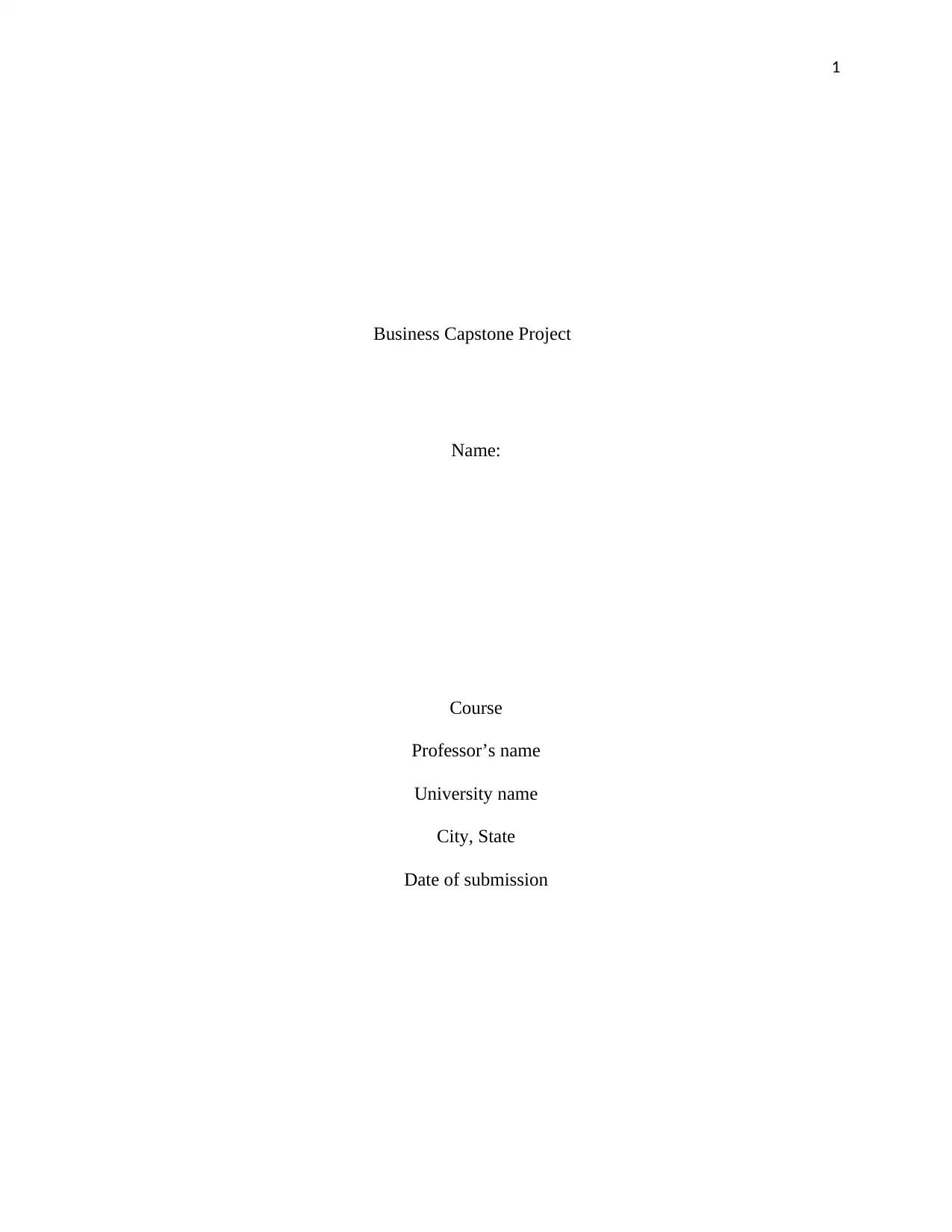
1
Business Capstone Project
Name:
Course
Professor’s name
University name
City, State
Date of submission
Business Capstone Project
Name:
Course
Professor’s name
University name
City, State
Date of submission
Paraphrase This Document
Need a fresh take? Get an instant paraphrase of this document with our AI Paraphraser
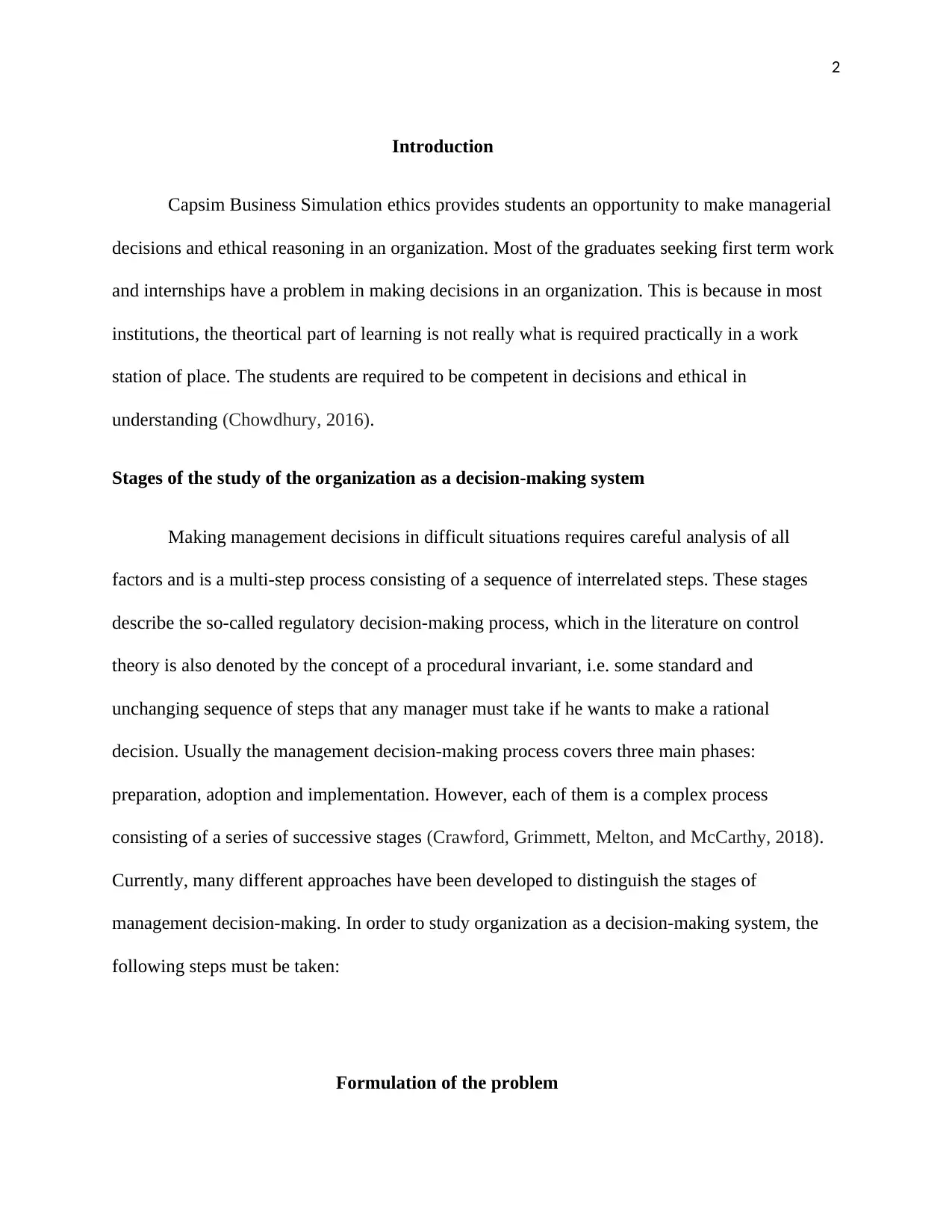
2
Introduction
Capsim Business Simulation ethics provides students an opportunity to make managerial
decisions and ethical reasoning in an organization. Most of the graduates seeking first term work
and internships have a problem in making decisions in an organization. This is because in most
institutions, the theortical part of learning is not really what is required practically in a work
station of place. The students are required to be competent in decisions and ethical in
understanding (Chowdhury, 2016).
Stages of the study of the organization as a decision-making system
Making management decisions in difficult situations requires careful analysis of all
factors and is a multi-step process consisting of a sequence of interrelated steps. These stages
describe the so-called regulatory decision-making process, which in the literature on control
theory is also denoted by the concept of a procedural invariant, i.e. some standard and
unchanging sequence of steps that any manager must take if he wants to make a rational
decision. Usually the management decision-making process covers three main phases:
preparation, adoption and implementation. However, each of them is a complex process
consisting of a series of successive stages (Crawford, Grimmett, Melton, and McCarthy, 2018).
Currently, many different approaches have been developed to distinguish the stages of
management decision-making. In order to study organization as a decision-making system, the
following steps must be taken:
Formulation of the problem
Introduction
Capsim Business Simulation ethics provides students an opportunity to make managerial
decisions and ethical reasoning in an organization. Most of the graduates seeking first term work
and internships have a problem in making decisions in an organization. This is because in most
institutions, the theortical part of learning is not really what is required practically in a work
station of place. The students are required to be competent in decisions and ethical in
understanding (Chowdhury, 2016).
Stages of the study of the organization as a decision-making system
Making management decisions in difficult situations requires careful analysis of all
factors and is a multi-step process consisting of a sequence of interrelated steps. These stages
describe the so-called regulatory decision-making process, which in the literature on control
theory is also denoted by the concept of a procedural invariant, i.e. some standard and
unchanging sequence of steps that any manager must take if he wants to make a rational
decision. Usually the management decision-making process covers three main phases:
preparation, adoption and implementation. However, each of them is a complex process
consisting of a series of successive stages (Crawford, Grimmett, Melton, and McCarthy, 2018).
Currently, many different approaches have been developed to distinguish the stages of
management decision-making. In order to study organization as a decision-making system, the
following steps must be taken:
Formulation of the problem
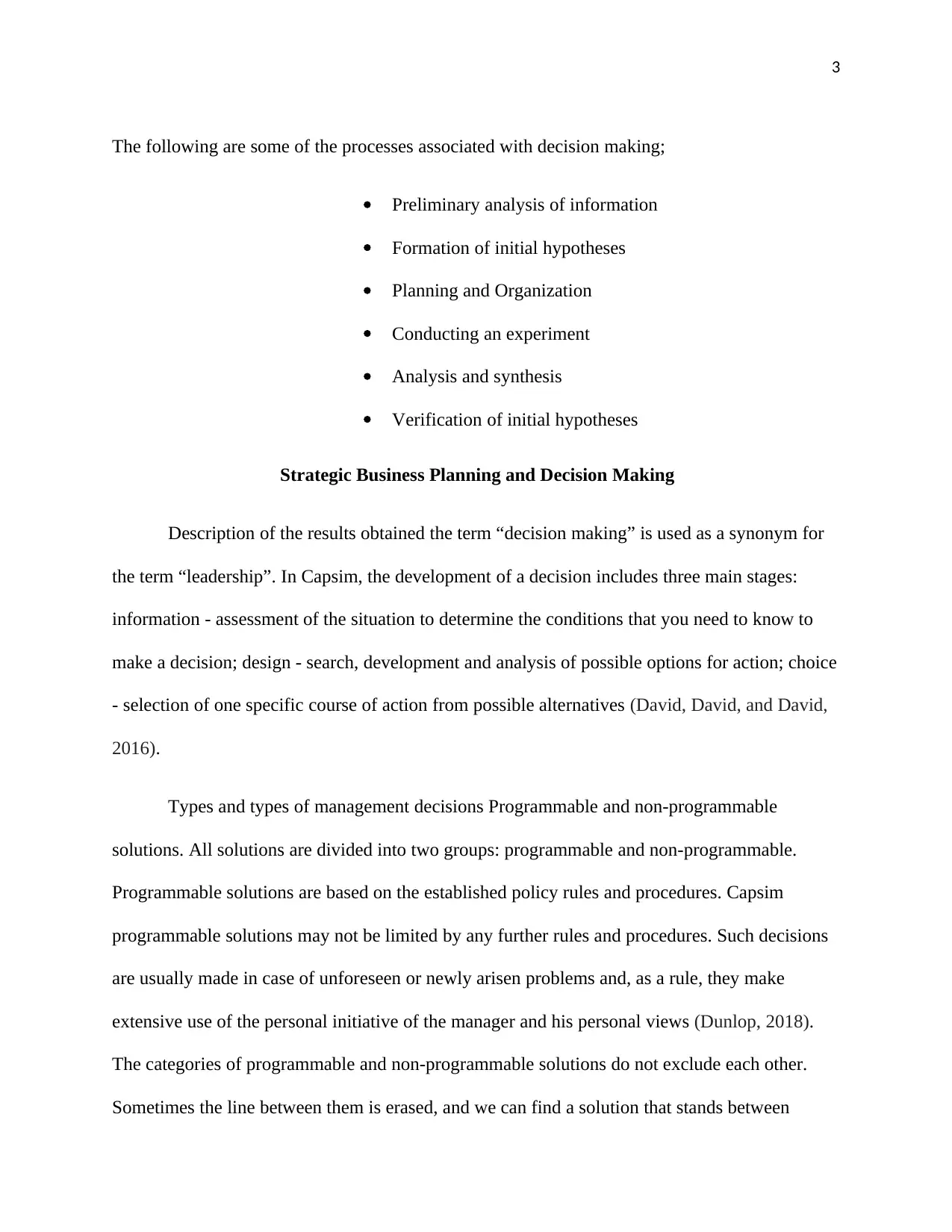
3
The following are some of the processes associated with decision making;
Preliminary analysis of information
Formation of initial hypotheses
Planning and Organization
Conducting an experiment
Analysis and synthesis
Verification of initial hypotheses
Strategic Business Planning and Decision Making
Description of the results obtained the term “decision making” is used as a synonym for
the term “leadership”. In Capsim, the development of a decision includes three main stages:
information - assessment of the situation to determine the conditions that you need to know to
make a decision; design - search, development and analysis of possible options for action; choice
- selection of one specific course of action from possible alternatives (David, David, and David,
2016).
Types and types of management decisions Programmable and non-programmable
solutions. All solutions are divided into two groups: programmable and non-programmable.
Programmable solutions are based on the established policy rules and procedures. Capsim
programmable solutions may not be limited by any further rules and procedures. Such decisions
are usually made in case of unforeseen or newly arisen problems and, as a rule, they make
extensive use of the personal initiative of the manager and his personal views (Dunlop, 2018).
The categories of programmable and non-programmable solutions do not exclude each other.
Sometimes the line between them is erased, and we can find a solution that stands between
The following are some of the processes associated with decision making;
Preliminary analysis of information
Formation of initial hypotheses
Planning and Organization
Conducting an experiment
Analysis and synthesis
Verification of initial hypotheses
Strategic Business Planning and Decision Making
Description of the results obtained the term “decision making” is used as a synonym for
the term “leadership”. In Capsim, the development of a decision includes three main stages:
information - assessment of the situation to determine the conditions that you need to know to
make a decision; design - search, development and analysis of possible options for action; choice
- selection of one specific course of action from possible alternatives (David, David, and David,
2016).
Types and types of management decisions Programmable and non-programmable
solutions. All solutions are divided into two groups: programmable and non-programmable.
Programmable solutions are based on the established policy rules and procedures. Capsim
programmable solutions may not be limited by any further rules and procedures. Such decisions
are usually made in case of unforeseen or newly arisen problems and, as a rule, they make
extensive use of the personal initiative of the manager and his personal views (Dunlop, 2018).
The categories of programmable and non-programmable solutions do not exclude each other.
Sometimes the line between them is erased, and we can find a solution that stands between
⊘ This is a preview!⊘
Do you want full access?
Subscribe today to unlock all pages.

Trusted by 1+ million students worldwide
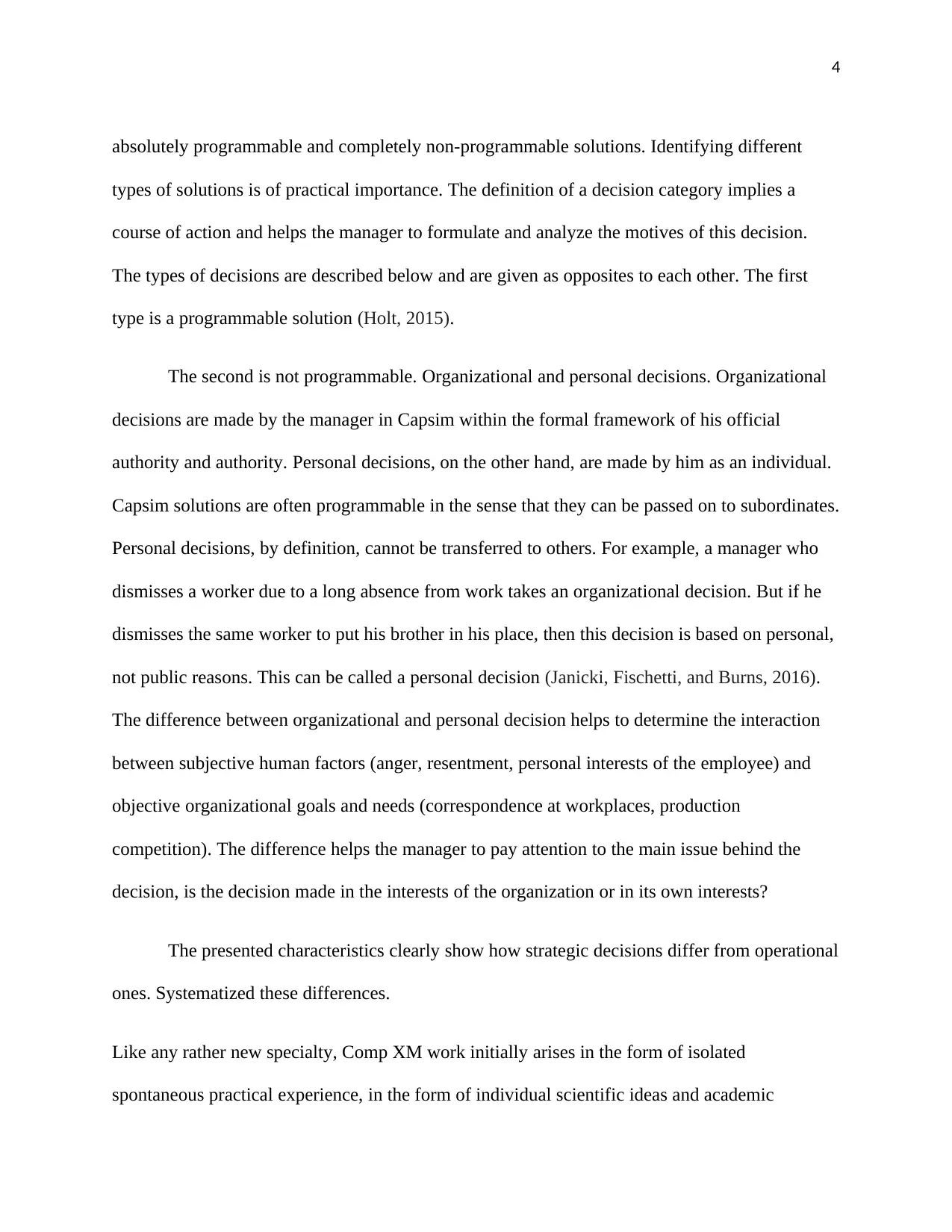
4
absolutely programmable and completely non-programmable solutions. Identifying different
types of solutions is of practical importance. The definition of a decision category implies a
course of action and helps the manager to formulate and analyze the motives of this decision.
The types of decisions are described below and are given as opposites to each other. The first
type is a programmable solution (Holt, 2015).
The second is not programmable. Organizational and personal decisions. Organizational
decisions are made by the manager in Capsim within the formal framework of his official
authority and authority. Personal decisions, on the other hand, are made by him as an individual.
Capsim solutions are often programmable in the sense that they can be passed on to subordinates.
Personal decisions, by definition, cannot be transferred to others. For example, a manager who
dismisses a worker due to a long absence from work takes an organizational decision. But if he
dismisses the same worker to put his brother in his place, then this decision is based on personal,
not public reasons. This can be called a personal decision (Janicki, Fischetti, and Burns, 2016).
The difference between organizational and personal decision helps to determine the interaction
between subjective human factors (anger, resentment, personal interests of the employee) and
objective organizational goals and needs (correspondence at workplaces, production
competition). The difference helps the manager to pay attention to the main issue behind the
decision, is the decision made in the interests of the organization or in its own interests?
The presented characteristics clearly show how strategic decisions differ from operational
ones. Systematized these differences.
Like any rather new specialty, Comp XM work initially arises in the form of isolated
spontaneous practical experience, in the form of individual scientific ideas and academic
absolutely programmable and completely non-programmable solutions. Identifying different
types of solutions is of practical importance. The definition of a decision category implies a
course of action and helps the manager to formulate and analyze the motives of this decision.
The types of decisions are described below and are given as opposites to each other. The first
type is a programmable solution (Holt, 2015).
The second is not programmable. Organizational and personal decisions. Organizational
decisions are made by the manager in Capsim within the formal framework of his official
authority and authority. Personal decisions, on the other hand, are made by him as an individual.
Capsim solutions are often programmable in the sense that they can be passed on to subordinates.
Personal decisions, by definition, cannot be transferred to others. For example, a manager who
dismisses a worker due to a long absence from work takes an organizational decision. But if he
dismisses the same worker to put his brother in his place, then this decision is based on personal,
not public reasons. This can be called a personal decision (Janicki, Fischetti, and Burns, 2016).
The difference between organizational and personal decision helps to determine the interaction
between subjective human factors (anger, resentment, personal interests of the employee) and
objective organizational goals and needs (correspondence at workplaces, production
competition). The difference helps the manager to pay attention to the main issue behind the
decision, is the decision made in the interests of the organization or in its own interests?
The presented characteristics clearly show how strategic decisions differ from operational
ones. Systematized these differences.
Like any rather new specialty, Comp XM work initially arises in the form of isolated
spontaneous practical experience, in the form of individual scientific ideas and academic
Paraphrase This Document
Need a fresh take? Get an instant paraphrase of this document with our AI Paraphraser
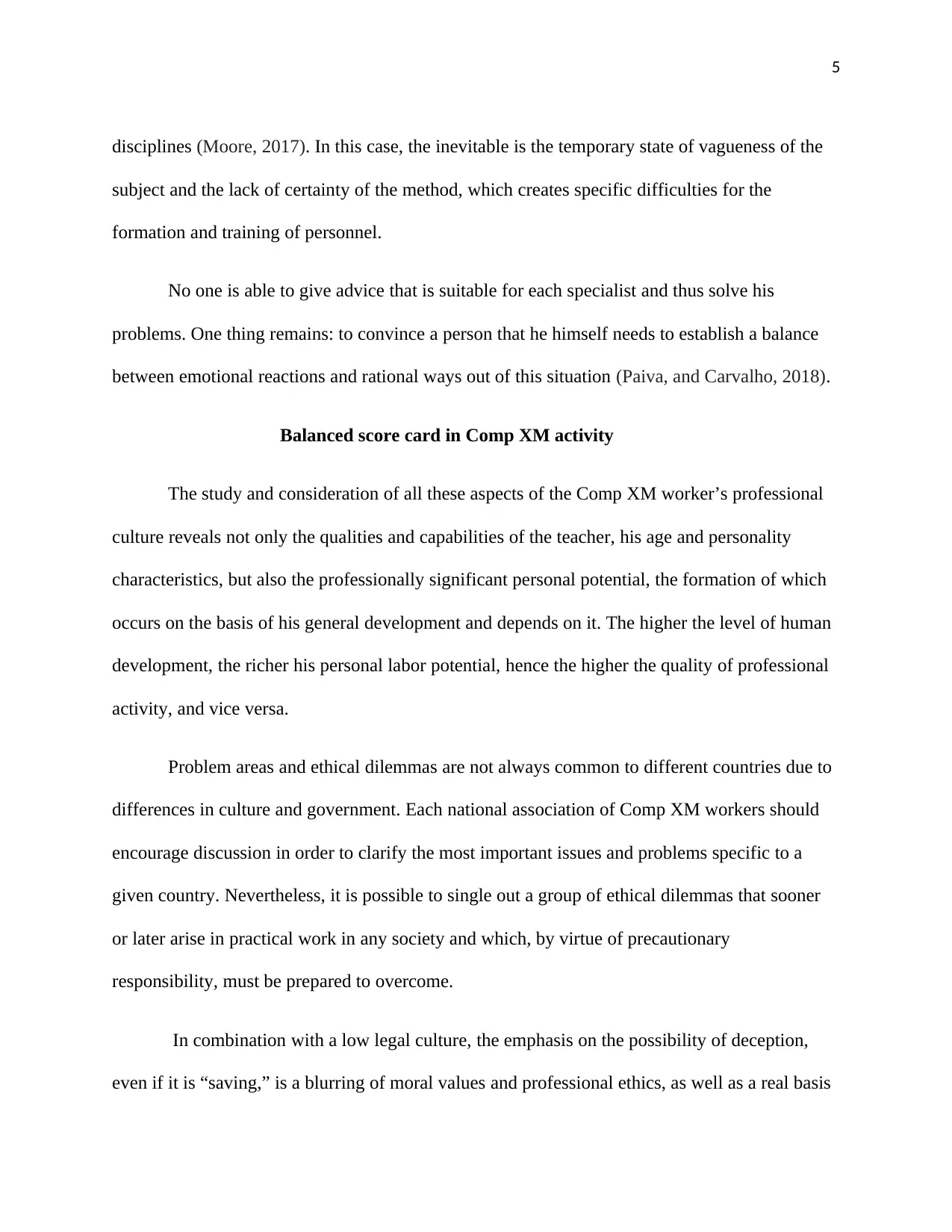
5
disciplines (Moore, 2017). In this case, the inevitable is the temporary state of vagueness of the
subject and the lack of certainty of the method, which creates specific difficulties for the
formation and training of personnel.
No one is able to give advice that is suitable for each specialist and thus solve his
problems. One thing remains: to convince a person that he himself needs to establish a balance
between emotional reactions and rational ways out of this situation (Paiva, and Carvalho, 2018).
Balanced score card in Comp XM activity
The study and consideration of all these aspects of the Comp XM worker’s professional
culture reveals not only the qualities and capabilities of the teacher, his age and personality
characteristics, but also the professionally significant personal potential, the formation of which
occurs on the basis of his general development and depends on it. The higher the level of human
development, the richer his personal labor potential, hence the higher the quality of professional
activity, and vice versa.
Problem areas and ethical dilemmas are not always common to different countries due to
differences in culture and government. Each national association of Comp XM workers should
encourage discussion in order to clarify the most important issues and problems specific to a
given country. Nevertheless, it is possible to single out a group of ethical dilemmas that sooner
or later arise in practical work in any society and which, by virtue of precautionary
responsibility, must be prepared to overcome.
In combination with a low legal culture, the emphasis on the possibility of deception,
even if it is “saving,” is a blurring of moral values and professional ethics, as well as a real basis
disciplines (Moore, 2017). In this case, the inevitable is the temporary state of vagueness of the
subject and the lack of certainty of the method, which creates specific difficulties for the
formation and training of personnel.
No one is able to give advice that is suitable for each specialist and thus solve his
problems. One thing remains: to convince a person that he himself needs to establish a balance
between emotional reactions and rational ways out of this situation (Paiva, and Carvalho, 2018).
Balanced score card in Comp XM activity
The study and consideration of all these aspects of the Comp XM worker’s professional
culture reveals not only the qualities and capabilities of the teacher, his age and personality
characteristics, but also the professionally significant personal potential, the formation of which
occurs on the basis of his general development and depends on it. The higher the level of human
development, the richer his personal labor potential, hence the higher the quality of professional
activity, and vice versa.
Problem areas and ethical dilemmas are not always common to different countries due to
differences in culture and government. Each national association of Comp XM workers should
encourage discussion in order to clarify the most important issues and problems specific to a
given country. Nevertheless, it is possible to single out a group of ethical dilemmas that sooner
or later arise in practical work in any society and which, by virtue of precautionary
responsibility, must be prepared to overcome.
In combination with a low legal culture, the emphasis on the possibility of deception,
even if it is “saving,” is a blurring of moral values and professional ethics, as well as a real basis
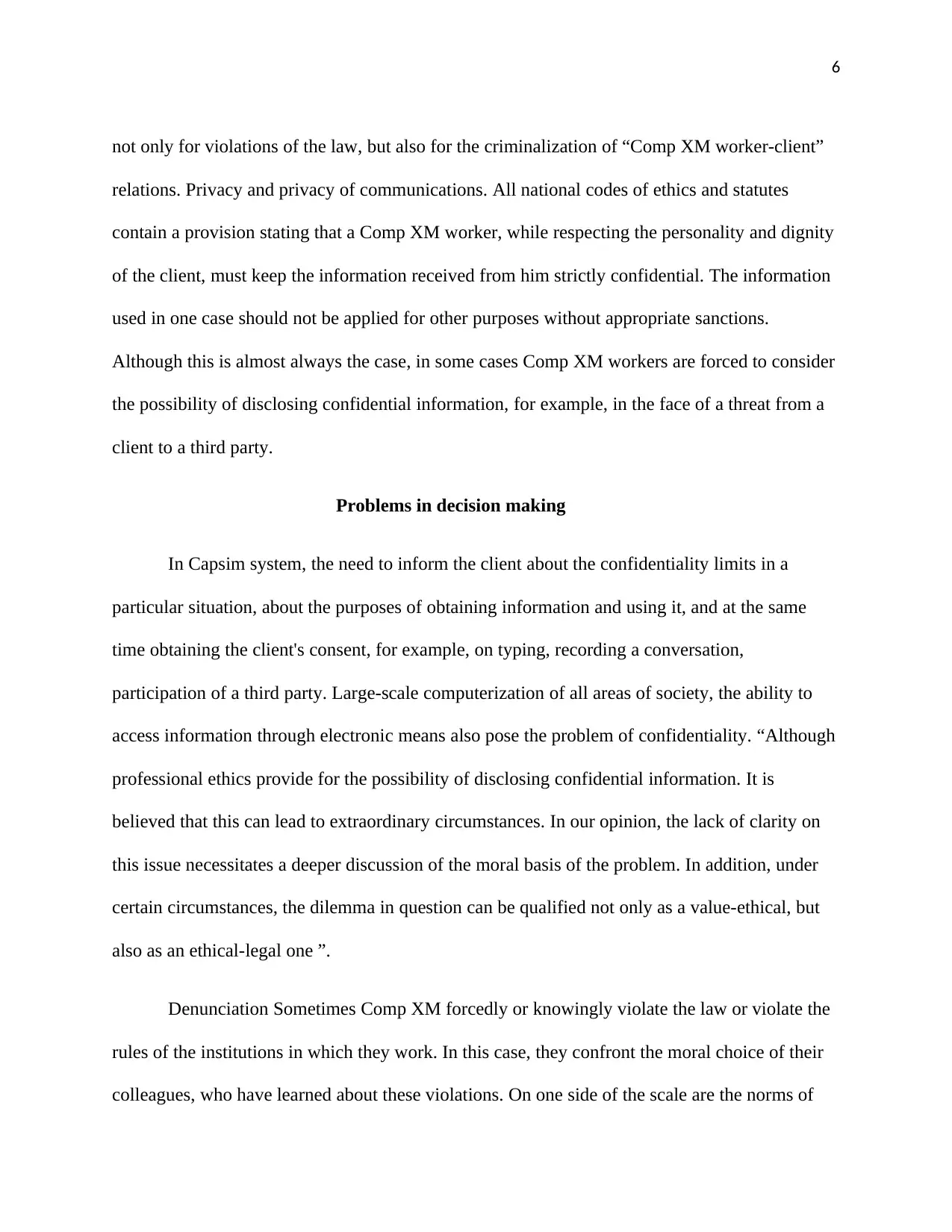
6
not only for violations of the law, but also for the criminalization of “Comp XM worker-client”
relations. Privacy and privacy of communications. All national codes of ethics and statutes
contain a provision stating that a Comp XM worker, while respecting the personality and dignity
of the client, must keep the information received from him strictly confidential. The information
used in one case should not be applied for other purposes without appropriate sanctions.
Although this is almost always the case, in some cases Comp XM workers are forced to consider
the possibility of disclosing confidential information, for example, in the face of a threat from a
client to a third party.
Problems in decision making
In Capsim system, the need to inform the client about the confidentiality limits in a
particular situation, about the purposes of obtaining information and using it, and at the same
time obtaining the client's consent, for example, on typing, recording a conversation,
participation of a third party. Large-scale computerization of all areas of society, the ability to
access information through electronic means also pose the problem of confidentiality. “Although
professional ethics provide for the possibility of disclosing confidential information. It is
believed that this can lead to extraordinary circumstances. In our opinion, the lack of clarity on
this issue necessitates a deeper discussion of the moral basis of the problem. In addition, under
certain circumstances, the dilemma in question can be qualified not only as a value-ethical, but
also as an ethical-legal one ”.
Denunciation Sometimes Comp XM forcedly or knowingly violate the law or violate the
rules of the institutions in which they work. In this case, they confront the moral choice of their
colleagues, who have learned about these violations. On one side of the scale are the norms of
not only for violations of the law, but also for the criminalization of “Comp XM worker-client”
relations. Privacy and privacy of communications. All national codes of ethics and statutes
contain a provision stating that a Comp XM worker, while respecting the personality and dignity
of the client, must keep the information received from him strictly confidential. The information
used in one case should not be applied for other purposes without appropriate sanctions.
Although this is almost always the case, in some cases Comp XM workers are forced to consider
the possibility of disclosing confidential information, for example, in the face of a threat from a
client to a third party.
Problems in decision making
In Capsim system, the need to inform the client about the confidentiality limits in a
particular situation, about the purposes of obtaining information and using it, and at the same
time obtaining the client's consent, for example, on typing, recording a conversation,
participation of a third party. Large-scale computerization of all areas of society, the ability to
access information through electronic means also pose the problem of confidentiality. “Although
professional ethics provide for the possibility of disclosing confidential information. It is
believed that this can lead to extraordinary circumstances. In our opinion, the lack of clarity on
this issue necessitates a deeper discussion of the moral basis of the problem. In addition, under
certain circumstances, the dilemma in question can be qualified not only as a value-ethical, but
also as an ethical-legal one ”.
Denunciation Sometimes Comp XM forcedly or knowingly violate the law or violate the
rules of the institutions in which they work. In this case, they confront the moral choice of their
colleagues, who have learned about these violations. On one side of the scale are the norms of
⊘ This is a preview!⊘
Do you want full access?
Subscribe today to unlock all pages.

Trusted by 1+ million students worldwide
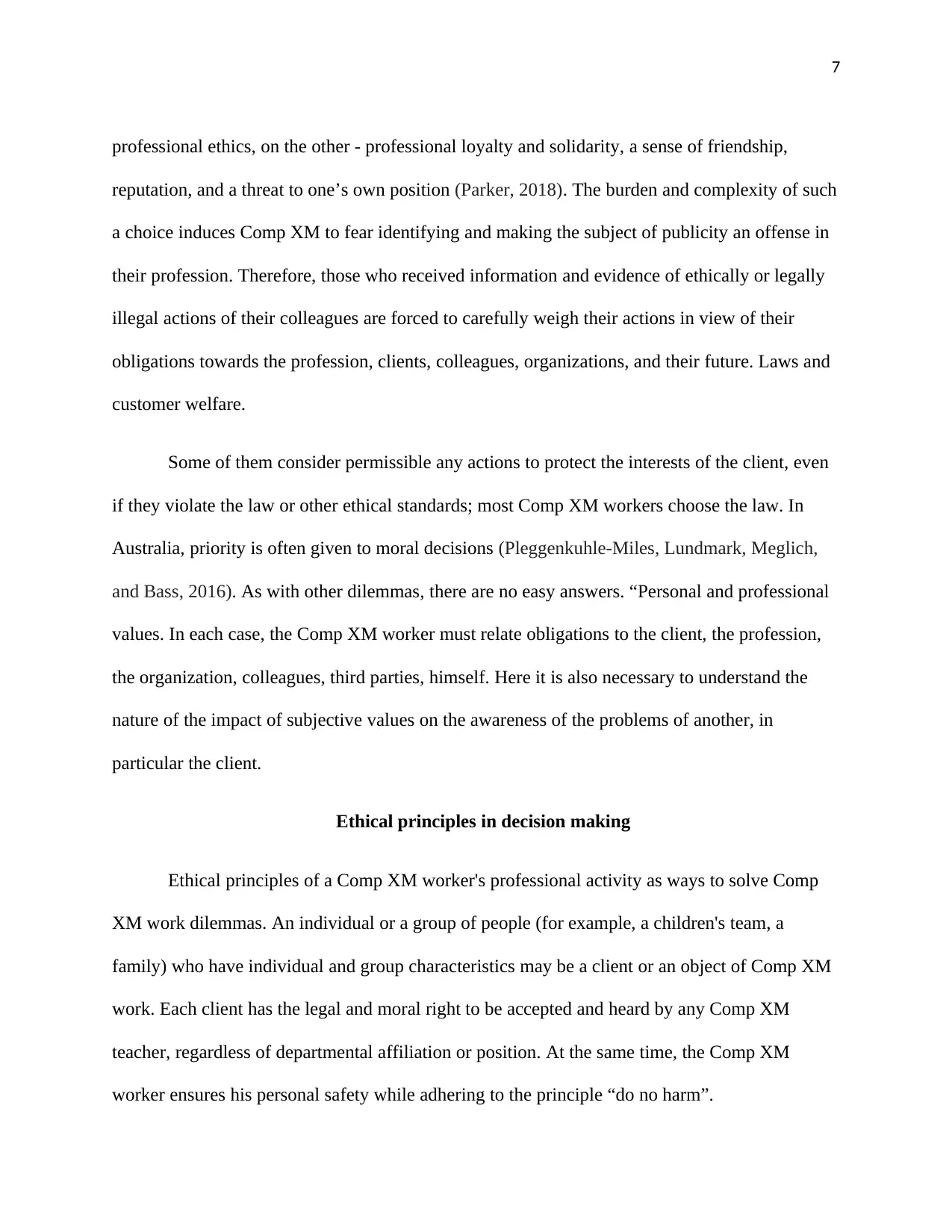
7
professional ethics, on the other - professional loyalty and solidarity, a sense of friendship,
reputation, and a threat to one’s own position (Parker, 2018). The burden and complexity of such
a choice induces Comp XM to fear identifying and making the subject of publicity an offense in
their profession. Therefore, those who received information and evidence of ethically or legally
illegal actions of their colleagues are forced to carefully weigh their actions in view of their
obligations towards the profession, clients, colleagues, organizations, and their future. Laws and
customer welfare.
Some of them consider permissible any actions to protect the interests of the client, even
if they violate the law or other ethical standards; most Comp XM workers choose the law. In
Australia, priority is often given to moral decisions (Pleggenkuhle-Miles, Lundmark, Meglich,
and Bass, 2016). As with other dilemmas, there are no easy answers. “Personal and professional
values. In each case, the Comp XM worker must relate obligations to the client, the profession,
the organization, colleagues, third parties, himself. Here it is also necessary to understand the
nature of the impact of subjective values on the awareness of the problems of another, in
particular the client.
Ethical principles in decision making
Ethical principles of a Comp XM worker's professional activity as ways to solve Comp
XM work dilemmas. An individual or a group of people (for example, a children's team, a
family) who have individual and group characteristics may be a client or an object of Comp XM
work. Each client has the legal and moral right to be accepted and heard by any Comp XM
teacher, regardless of departmental affiliation or position. At the same time, the Comp XM
worker ensures his personal safety while adhering to the principle “do no harm”.
professional ethics, on the other - professional loyalty and solidarity, a sense of friendship,
reputation, and a threat to one’s own position (Parker, 2018). The burden and complexity of such
a choice induces Comp XM to fear identifying and making the subject of publicity an offense in
their profession. Therefore, those who received information and evidence of ethically or legally
illegal actions of their colleagues are forced to carefully weigh their actions in view of their
obligations towards the profession, clients, colleagues, organizations, and their future. Laws and
customer welfare.
Some of them consider permissible any actions to protect the interests of the client, even
if they violate the law or other ethical standards; most Comp XM workers choose the law. In
Australia, priority is often given to moral decisions (Pleggenkuhle-Miles, Lundmark, Meglich,
and Bass, 2016). As with other dilemmas, there are no easy answers. “Personal and professional
values. In each case, the Comp XM worker must relate obligations to the client, the profession,
the organization, colleagues, third parties, himself. Here it is also necessary to understand the
nature of the impact of subjective values on the awareness of the problems of another, in
particular the client.
Ethical principles in decision making
Ethical principles of a Comp XM worker's professional activity as ways to solve Comp
XM work dilemmas. An individual or a group of people (for example, a children's team, a
family) who have individual and group characteristics may be a client or an object of Comp XM
work. Each client has the legal and moral right to be accepted and heard by any Comp XM
teacher, regardless of departmental affiliation or position. At the same time, the Comp XM
worker ensures his personal safety while adhering to the principle “do no harm”.
Paraphrase This Document
Need a fresh take? Get an instant paraphrase of this document with our AI Paraphraser
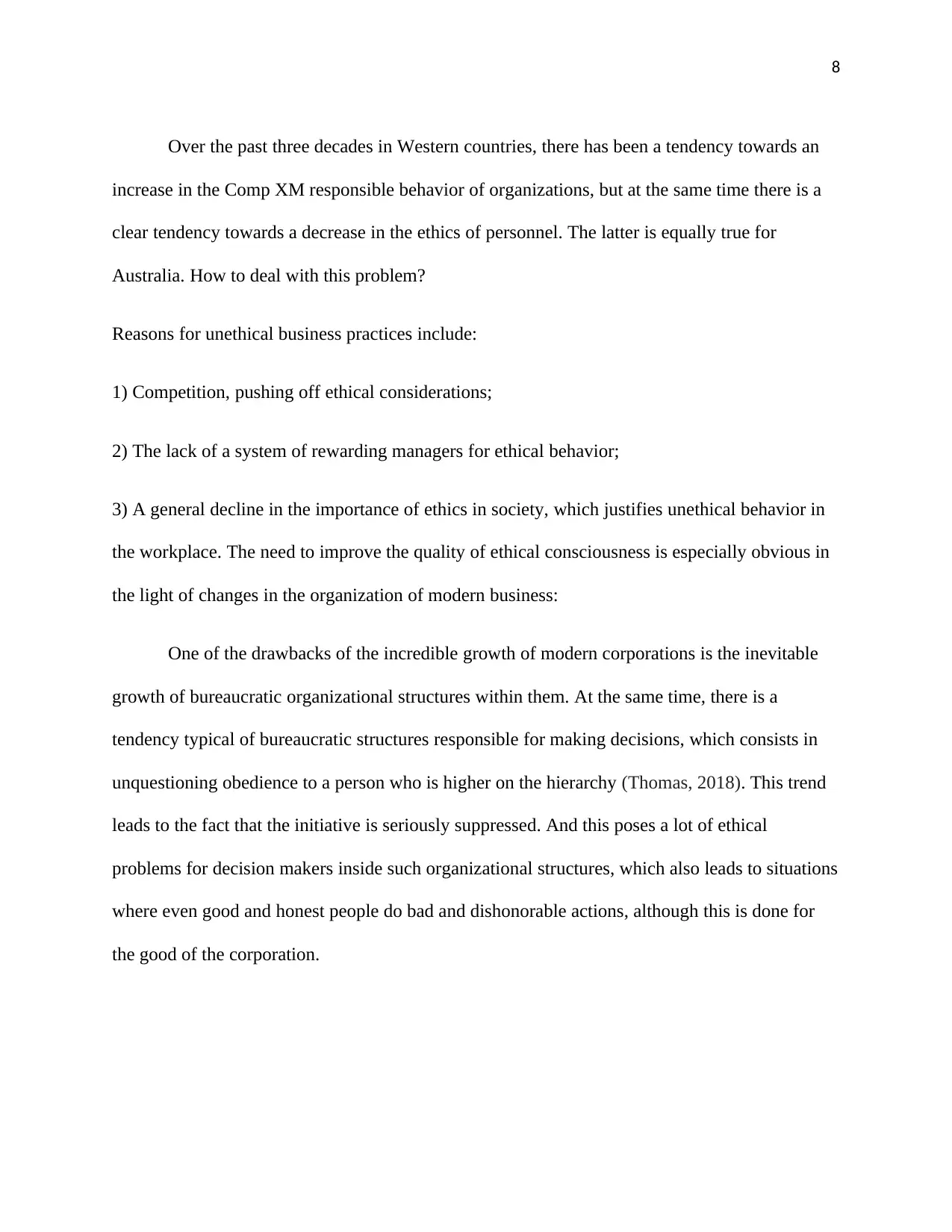
8
Over the past three decades in Western countries, there has been a tendency towards an
increase in the Comp XM responsible behavior of organizations, but at the same time there is a
clear tendency towards a decrease in the ethics of personnel. The latter is equally true for
Australia. How to deal with this problem?
Reasons for unethical business practices include:
1) Competition, pushing off ethical considerations;
2) The lack of a system of rewarding managers for ethical behavior;
3) A general decline in the importance of ethics in society, which justifies unethical behavior in
the workplace. The need to improve the quality of ethical consciousness is especially obvious in
the light of changes in the organization of modern business:
One of the drawbacks of the incredible growth of modern corporations is the inevitable
growth of bureaucratic organizational structures within them. At the same time, there is a
tendency typical of bureaucratic structures responsible for making decisions, which consists in
unquestioning obedience to a person who is higher on the hierarchy (Thomas, 2018). This trend
leads to the fact that the initiative is seriously suppressed. And this poses a lot of ethical
problems for decision makers inside such organizational structures, which also leads to situations
where even good and honest people do bad and dishonorable actions, although this is done for
the good of the corporation.
Over the past three decades in Western countries, there has been a tendency towards an
increase in the Comp XM responsible behavior of organizations, but at the same time there is a
clear tendency towards a decrease in the ethics of personnel. The latter is equally true for
Australia. How to deal with this problem?
Reasons for unethical business practices include:
1) Competition, pushing off ethical considerations;
2) The lack of a system of rewarding managers for ethical behavior;
3) A general decline in the importance of ethics in society, which justifies unethical behavior in
the workplace. The need to improve the quality of ethical consciousness is especially obvious in
the light of changes in the organization of modern business:
One of the drawbacks of the incredible growth of modern corporations is the inevitable
growth of bureaucratic organizational structures within them. At the same time, there is a
tendency typical of bureaucratic structures responsible for making decisions, which consists in
unquestioning obedience to a person who is higher on the hierarchy (Thomas, 2018). This trend
leads to the fact that the initiative is seriously suppressed. And this poses a lot of ethical
problems for decision makers inside such organizational structures, which also leads to situations
where even good and honest people do bad and dishonorable actions, although this is done for
the good of the corporation.
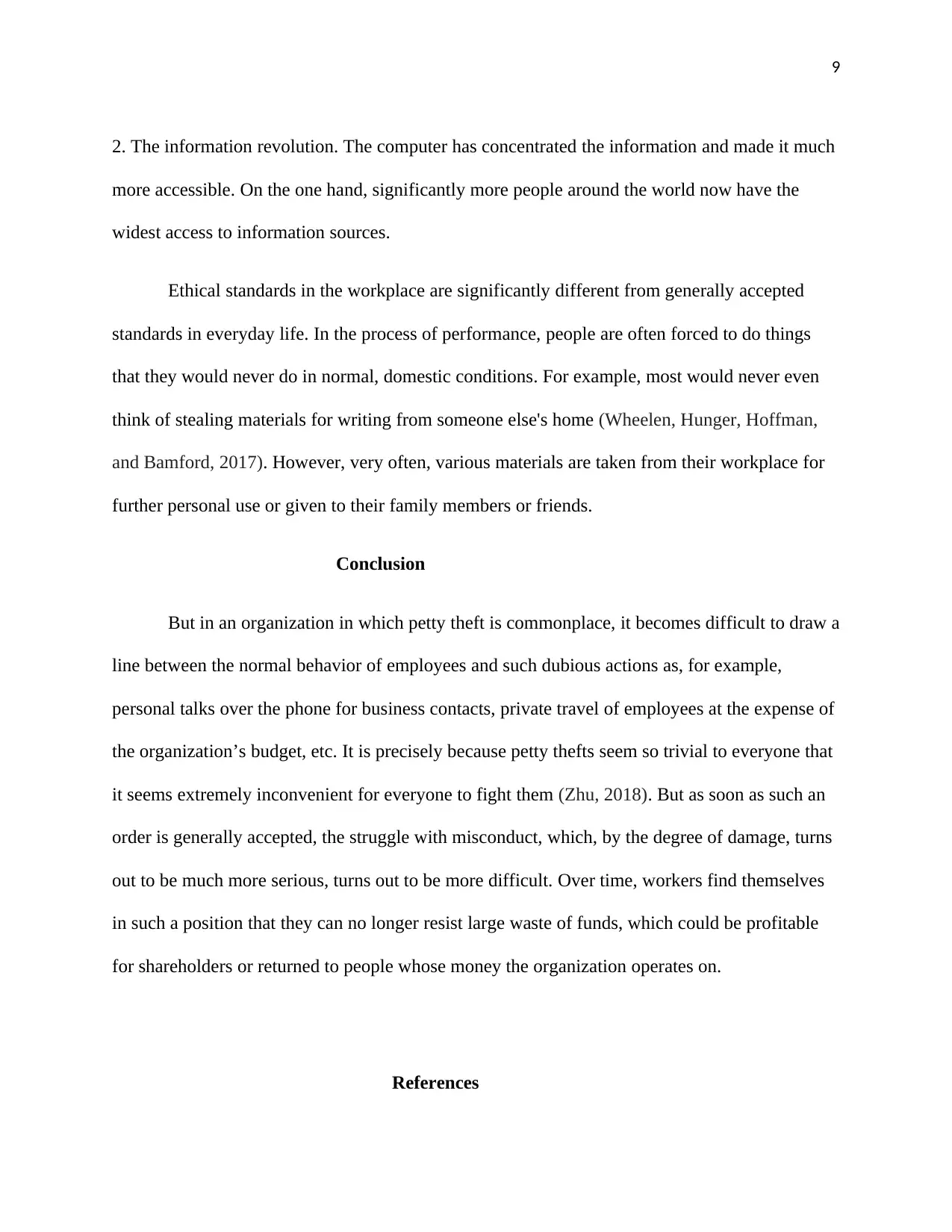
9
2. The information revolution. The computer has concentrated the information and made it much
more accessible. On the one hand, significantly more people around the world now have the
widest access to information sources.
Ethical standards in the workplace are significantly different from generally accepted
standards in everyday life. In the process of performance, people are often forced to do things
that they would never do in normal, domestic conditions. For example, most would never even
think of stealing materials for writing from someone else's home (Wheelen, Hunger, Hoffman,
and Bamford, 2017). However, very often, various materials are taken from their workplace for
further personal use or given to their family members or friends.
Conclusion
But in an organization in which petty theft is commonplace, it becomes difficult to draw a
line between the normal behavior of employees and such dubious actions as, for example,
personal talks over the phone for business contacts, private travel of employees at the expense of
the organization’s budget, etc. It is precisely because petty thefts seem so trivial to everyone that
it seems extremely inconvenient for everyone to fight them (Zhu, 2018). But as soon as such an
order is generally accepted, the struggle with misconduct, which, by the degree of damage, turns
out to be much more serious, turns out to be more difficult. Over time, workers find themselves
in such a position that they can no longer resist large waste of funds, which could be profitable
for shareholders or returned to people whose money the organization operates on.
References
2. The information revolution. The computer has concentrated the information and made it much
more accessible. On the one hand, significantly more people around the world now have the
widest access to information sources.
Ethical standards in the workplace are significantly different from generally accepted
standards in everyday life. In the process of performance, people are often forced to do things
that they would never do in normal, domestic conditions. For example, most would never even
think of stealing materials for writing from someone else's home (Wheelen, Hunger, Hoffman,
and Bamford, 2017). However, very often, various materials are taken from their workplace for
further personal use or given to their family members or friends.
Conclusion
But in an organization in which petty theft is commonplace, it becomes difficult to draw a
line between the normal behavior of employees and such dubious actions as, for example,
personal talks over the phone for business contacts, private travel of employees at the expense of
the organization’s budget, etc. It is precisely because petty thefts seem so trivial to everyone that
it seems extremely inconvenient for everyone to fight them (Zhu, 2018). But as soon as such an
order is generally accepted, the struggle with misconduct, which, by the degree of damage, turns
out to be much more serious, turns out to be more difficult. Over time, workers find themselves
in such a position that they can no longer resist large waste of funds, which could be profitable
for shareholders or returned to people whose money the organization operates on.
References
⊘ This is a preview!⊘
Do you want full access?
Subscribe today to unlock all pages.

Trusted by 1+ million students worldwide
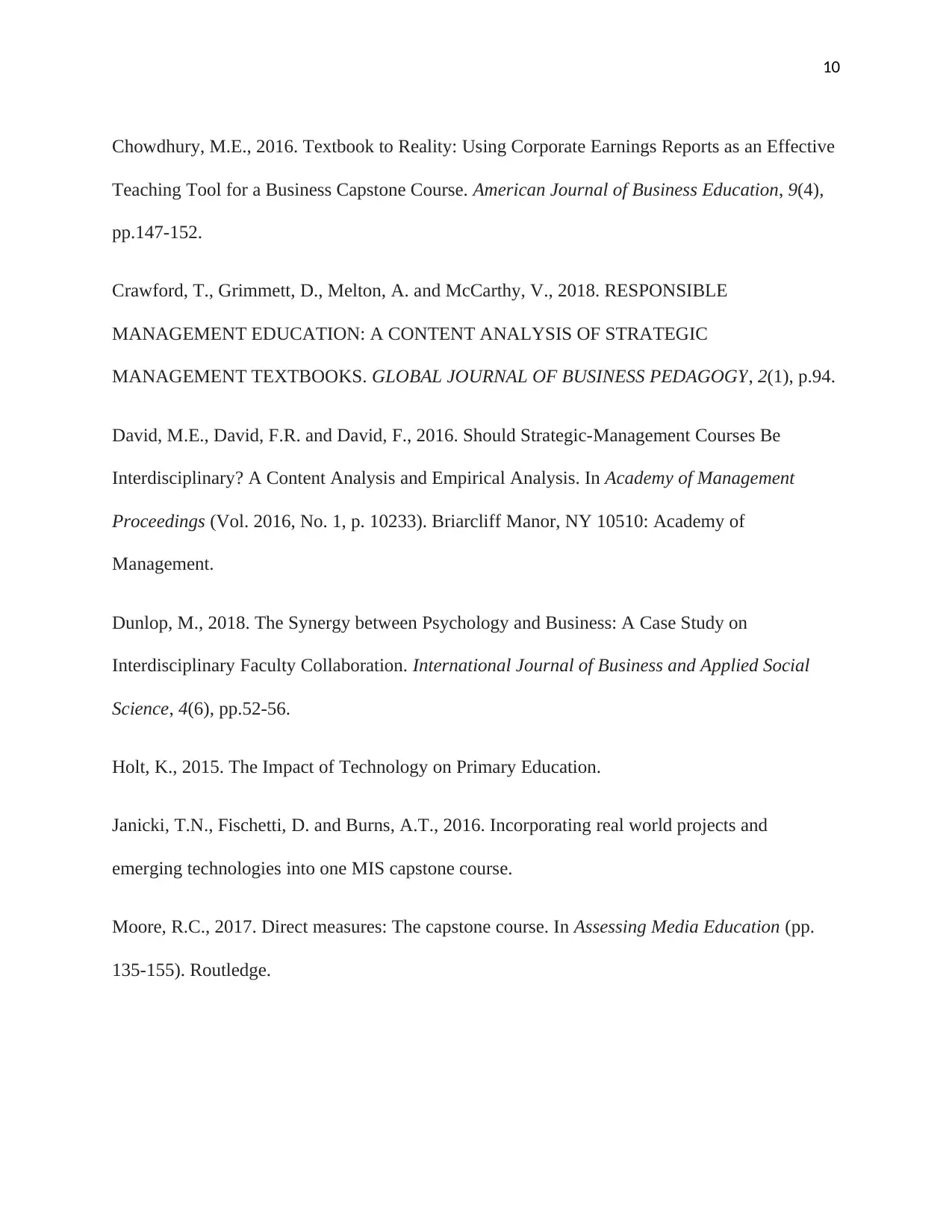
10
Chowdhury, M.E., 2016. Textbook to Reality: Using Corporate Earnings Reports as an Effective
Teaching Tool for a Business Capstone Course. American Journal of Business Education, 9(4),
pp.147-152.
Crawford, T., Grimmett, D., Melton, A. and McCarthy, V., 2018. RESPONSIBLE
MANAGEMENT EDUCATION: A CONTENT ANALYSIS OF STRATEGIC
MANAGEMENT TEXTBOOKS. GLOBAL JOURNAL OF BUSINESS PEDAGOGY, 2(1), p.94.
David, M.E., David, F.R. and David, F., 2016. Should Strategic-Management Courses Be
Interdisciplinary? A Content Analysis and Empirical Analysis. In Academy of Management
Proceedings (Vol. 2016, No. 1, p. 10233). Briarcliff Manor, NY 10510: Academy of
Management.
Dunlop, M., 2018. The Synergy between Psychology and Business: A Case Study on
Interdisciplinary Faculty Collaboration. International Journal of Business and Applied Social
Science, 4(6), pp.52-56.
Holt, K., 2015. The Impact of Technology on Primary Education.
Janicki, T.N., Fischetti, D. and Burns, A.T., 2016. Incorporating real world projects and
emerging technologies into one MIS capstone course.
Moore, R.C., 2017. Direct measures: The capstone course. In Assessing Media Education (pp.
135-155). Routledge.
Chowdhury, M.E., 2016. Textbook to Reality: Using Corporate Earnings Reports as an Effective
Teaching Tool for a Business Capstone Course. American Journal of Business Education, 9(4),
pp.147-152.
Crawford, T., Grimmett, D., Melton, A. and McCarthy, V., 2018. RESPONSIBLE
MANAGEMENT EDUCATION: A CONTENT ANALYSIS OF STRATEGIC
MANAGEMENT TEXTBOOKS. GLOBAL JOURNAL OF BUSINESS PEDAGOGY, 2(1), p.94.
David, M.E., David, F.R. and David, F., 2016. Should Strategic-Management Courses Be
Interdisciplinary? A Content Analysis and Empirical Analysis. In Academy of Management
Proceedings (Vol. 2016, No. 1, p. 10233). Briarcliff Manor, NY 10510: Academy of
Management.
Dunlop, M., 2018. The Synergy between Psychology and Business: A Case Study on
Interdisciplinary Faculty Collaboration. International Journal of Business and Applied Social
Science, 4(6), pp.52-56.
Holt, K., 2015. The Impact of Technology on Primary Education.
Janicki, T.N., Fischetti, D. and Burns, A.T., 2016. Incorporating real world projects and
emerging technologies into one MIS capstone course.
Moore, R.C., 2017. Direct measures: The capstone course. In Assessing Media Education (pp.
135-155). Routledge.
Paraphrase This Document
Need a fresh take? Get an instant paraphrase of this document with our AI Paraphraser
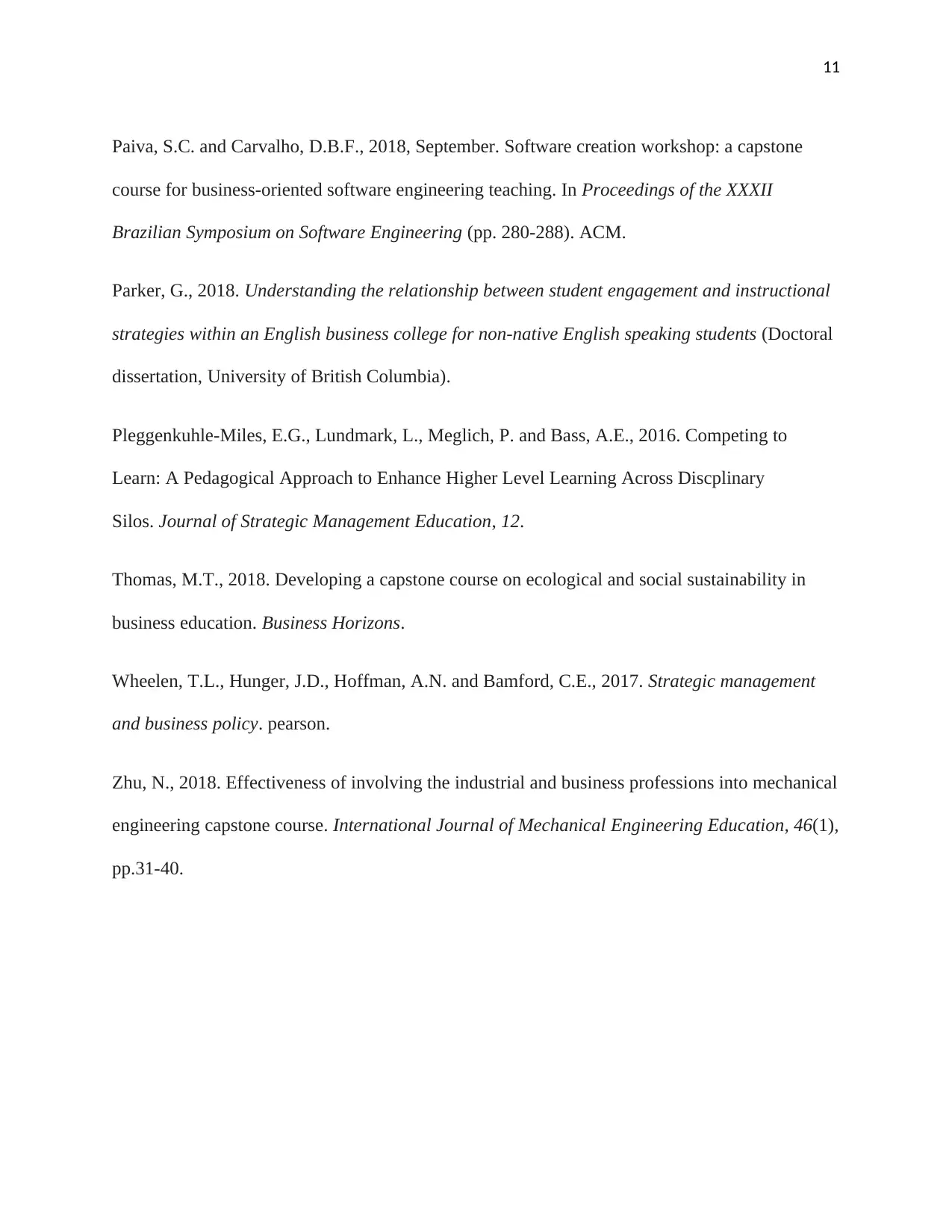
11
Paiva, S.C. and Carvalho, D.B.F., 2018, September. Software creation workshop: a capstone
course for business-oriented software engineering teaching. In Proceedings of the XXXII
Brazilian Symposium on Software Engineering (pp. 280-288). ACM.
Parker, G., 2018. Understanding the relationship between student engagement and instructional
strategies within an English business college for non-native English speaking students (Doctoral
dissertation, University of British Columbia).
Pleggenkuhle-Miles, E.G., Lundmark, L., Meglich, P. and Bass, A.E., 2016. Competing to
Learn: A Pedagogical Approach to Enhance Higher Level Learning Across Discplinary
Silos. Journal of Strategic Management Education, 12.
Thomas, M.T., 2018. Developing a capstone course on ecological and social sustainability in
business education. Business Horizons.
Wheelen, T.L., Hunger, J.D., Hoffman, A.N. and Bamford, C.E., 2017. Strategic management
and business policy. pearson.
Zhu, N., 2018. Effectiveness of involving the industrial and business professions into mechanical
engineering capstone course. International Journal of Mechanical Engineering Education, 46(1),
pp.31-40.
Paiva, S.C. and Carvalho, D.B.F., 2018, September. Software creation workshop: a capstone
course for business-oriented software engineering teaching. In Proceedings of the XXXII
Brazilian Symposium on Software Engineering (pp. 280-288). ACM.
Parker, G., 2018. Understanding the relationship between student engagement and instructional
strategies within an English business college for non-native English speaking students (Doctoral
dissertation, University of British Columbia).
Pleggenkuhle-Miles, E.G., Lundmark, L., Meglich, P. and Bass, A.E., 2016. Competing to
Learn: A Pedagogical Approach to Enhance Higher Level Learning Across Discplinary
Silos. Journal of Strategic Management Education, 12.
Thomas, M.T., 2018. Developing a capstone course on ecological and social sustainability in
business education. Business Horizons.
Wheelen, T.L., Hunger, J.D., Hoffman, A.N. and Bamford, C.E., 2017. Strategic management
and business policy. pearson.
Zhu, N., 2018. Effectiveness of involving the industrial and business professions into mechanical
engineering capstone course. International Journal of Mechanical Engineering Education, 46(1),
pp.31-40.
1 out of 11
Related Documents
Your All-in-One AI-Powered Toolkit for Academic Success.
+13062052269
info@desklib.com
Available 24*7 on WhatsApp / Email
![[object Object]](/_next/static/media/star-bottom.7253800d.svg)
Unlock your academic potential
Copyright © 2020–2025 A2Z Services. All Rights Reserved. Developed and managed by ZUCOL.





